Abstract
Purpose: Given the growth in the use of wearable measuring technology, this study aimed to investigate the frequency of writing about wearable monitoring devices in the field of sports sciences and sports-related health professions during the years affected by the COVID-19 pandemic (2020 to 2022). The goal was to observe the number of studies right before the quarantine and during the first years of pandemic. Methodology: A systematic literature analysis was performed in the Web of Science Core Collection (WoS CC) and Scopus databases in March 2023. The filters used in the search were the following: original scientific papers in the English language and open access. The research field was sports sciences in the past three years (2020–2022) in the Wos CC, and health professions and medicine in Scopus. Results: The initial search resulted in 54 studies in the WoS, 16 of which were included in a detailed qualitative analysis, and 297 studies in Scopus with 19 of them analyzed (35 altogether). The keywords used were “fitness watch” (sport watch, smartwatch), “smart shoes”, “smart clothing”, “smart ring”, “smart belt”, and “smart glasses”. In the past three years, there has been a steady increase in the number of studies using smart monitoring devices to measure their data (nine in 2020, nine in 2021, and seventeen in 2022). Results showed that the most used device is a smartwatch, while the most carried out studies were about physical activity and daily activities of living. Furthermore, there are more studies about measuring devices being used as testing equipment than about device performance in general. Conclusions: This study summarizes various research conducted in the field of sports with the use of wearable measuring devices to determine the frequency of use of such devices in sport studies.
1. Introduction
Wearable measuring devices have the ability to gather objective, real-time data on a range of physiological and biomechanical characteristics, offering insightful information on a person’s general health, fitness, and well-being. They can also wirelessly sync with other devices and programs to deliver information in the form of text notifications and data visualization, which users can then use for their self-assessment [1]. Oftentimes, they are utilized as tools for monitoring and evaluating exercise regimens and athletic training. Wearable technology has remained the top trend in fitness since it was first identified in the poll in 2016, except for 2018 and 2021 when it fell to third and second place, respectively [2] which shows their popularity and increased use in recreational use.
Several reviews were conducted in the last five years focusing on the effectiveness of wearable devices, especially smart watches and their use in medicine or health monitoring. King and Sarrafzadeh [3] in their review showed that the use of smartwatches has several limitations and their widespread adoption in health care has barriers. Another systematic review on smartwatches focused on their interaction using gesture recognition presenting several methods and applications that use the continuous recognition of gestures [4]. Furthermore, authors found positive outcomes in predicting the disease with the use of smartwatch and advocate for their continuous use in health care [5]. The potential of smartwatches in monitoring various health parameters and detecting diseases and the evolution of smartwatches in the biomedical sector was confirmed in another recent review [6].
The COVID-19 pandemic brought extensive research on activities and sedentary behavior, which was largely conducted using monitoring devices, that are acceptable in the socially distant world. Panicker and Chandrasekaran [7] authored a scoping review regarding the impact of wearables on physical health during the pandemic and concluded that wearables are a growing tool in improving physical activity and reducing sedentary behavior. Wearable devices have emerged as invaluable tools in the battle against the COVID-19 pandemic by promoting and enhancing individual health. These smart gadgets, ranging from fitness trackers to smartwatches, have played a pivotal role in monitoring vital health metrics, including heart rate, sleep patterns, and physical activity, thereby enabling individuals to proactively manage their well-being during these challenging times. Furthermore, the real-time data and alerts provided by these wearables have helped individuals detect potential symptoms early, facilitating timely medical intervention and reducing the risk of disease transmission. By fostering a sense of self-awareness and accountability in maintaining a healthy lifestyle, wearable devices have proven to be indispensable companions in the quest for optimal health amidst the ongoing global health crisis [8].
In this paper, we will cover recent developments on the subject of wearable technologies in sport in order to provide a summary of the current state of knowledge on this subject and to help to obtain a better understanding of it. Considering that “wearable technologies” are becoming an increasingly common way to monitor short-term and long-term training effects, the authors believe that the need for such papers is significant. The need for this type of research becomes particularly important during the pandemic, when a large number of recreational and elite athletes were forced to train individually, leading to a lack of coach assessment of training effects. This method of training monitoring enables coaches to obtain credible effects of the programmed training plan, which they have conveyed to their athletes in various ways.
Overall, there has not been an open access, indexed systematic review in the Web of Science or Scopus about the use of these devices in sport or physical activity in recent years. In the last five years there were several literature reviews on smartwatches that focused on the effectiveness of devices and their use in medicine or health monitoring. In their research, authors King and Sarrafzadeh [3] provided a comprehensive review of the use of smartwatches in healthcare applications and summarized the findings of various studies conducted in this field. They concluded that, at the time of the writing, the use of smartwatches has several limitations, and that their widespread adoption in health care has barriers. They suggested further research on the effectiveness of smartwatch-based healthcare applications in improving patient outcomes.
Another systematic literature on smartwatches focused on their interaction using gesture recognition [4]. The results of the surveys show several methods and applications that use the continuous recognition of gestures. Authors also present several promising approaches to gesture recognition that have, up until then, only been possible with image recognition.
Another systematic review brings research about diagnostic accuracy of smartwatches in the discovery of cardiac arrhythmia [5]. Authors found positive outcomes in predicting the disease with the use of smartwatch and advocate their continuous use in health care.
The authors of [6] compiled all the existing literature and discussed the evolution of smartwatches in the biomedical sector. The authors highlighted the potential of smartwatches in monitoring various health parameters and detecting diseases, while also discussing their challenges and limitations, such as accuracy and privacy concerns.
The COVID-19 pandemic brought about extensive research on activities and sedentary behavior, which was largely conducted using monitoring devices, that are acceptable in the socially distant world. Panicker and Chandrasekaran [7] made a scoping review of the impact of wearables on physical health during the pandemic and concluded that wearables are a growing tool in improving physical activity and reducing sedentary behavior.
Jat and Grønli [9] focused their review on the utilization of smart watches in health informatics and remote examination. They urge a complete analysis of the precision, outcome, and impact of wearables if they are to be included in healthcare. The application of smartwatches for medical use has potential but is still inconclusive in their accuracy as well as information security and privacy.
Additionally, a systematic review of systematic reviews was constructed to compare the therapeutic effectiveness of different watch-based interventions [10]. Authors established inconclusive results of clinical effectiveness of smart watches and the low methodological quality of the included systematic reviews.
Lastly, Pay et al. [11] examined studies on the topic of the detection of arrhythmias with the use of smartwatch beyond atrial fibrillation and are of the opinion that wearable monitoring devices have great potential for heart rhythm monitoring in patients with a high risk of arrhythmia but should be researched more to reduce false positive results and overdiagnosis.
Overall, there has not been a systematic literature review on the use of wearable devices in sport or physical activity. Therefore, a comprehensive review of the existing literature on wearable measuring devices in sport and physical activity is needed to provide a clear understanding of the current state of knowledge in this area. Such a review can summarize the findings and trends in the literature, perceive gaps, and provide directions for future research. This literature review aims to critically examine the existing literature on use of wearable measuring devices in sport and physical activity, providing a comprehensive overview of the current knowledge in this rapidly evolving field.
2. Materials and Methods
The purpose of this review is to provide a comprehensive analysis of studies conducted on wearable measuring devices within the realm of sports and physical activity, focusing on their efficacy as measurement tools. In order to accomplish this goal, a systematic literature search was conducted to locate original scientific papers exploring their application.
2.1. Research Questions
While wearables have already been widely adopted in various scientific fields, there is currently a lack of comprehensive reviews specifically focused on the sport science literature. This paper intends to offer an overview of wearables’ use in sport research over the previous three years in order to solve this gap and comprehend the growth and utility of wearables in the light of the recently developing circumstances brought about by the pandemic.
To guide the review process, several research questions were formulated. The first question (RQ1) aims to identify the year with the highest production of papers on the use of wearables, with a focus on determining whether the quarantine measures put in place in 2020 had an impact on the quantity of papers. Specifically, we investigate whether research conducted before the pandemic and published in 2020 differs from that conducted during the pandemic (2020–2021) and published in 2021–2022. The second research question (RQ2) focuses on the frequency of authors’ research and publication activities related to wearables. This involves examining the number of papers per author and the number of authors per paper to determine if researchers frequently conduct several studies incorporating wearables and if collaboration among authors or their affiliations is prevalent in this field. The monitoring devices used in the chosen studies are examined in the third research question (RQ3). To measure the variety of wearable technologies used in sport research and to demonstrate the scope of technological breakthroughs in this field, certain keywords were chosen (watch, shoes, clothes, ring, belt, and glasses). The fourth research question (RQ4) aims to identify the various activities that were measured using wearables. While the primary focus is on sport training (ST), the intention is to uncover any additional activities beyond the realm of sports that have been monitored using wearable devices (e.g., recreational activities). The fifth research question (RQ5) delves into the predominant use of wearables in a specific activity. This question seeks to determine whether wearables are more frequently used in sport training (ST) or if their use has spread to other types of physical activity (PA).
2.2. Databases for Literature Searching
To conduct the literature search, two major databases were chosen: Web of Science Core Collection (WoS CC) by Clarivate and Scopus by Elsevier. These databases were selected due to their prominence as major repositories of general scientific literature and citation indexes. The search was performed in the first half of March 2023 and yielded 15,798 and 5558 records, respectively, resulting in a combined total of 21,356 studies (Figure 1).
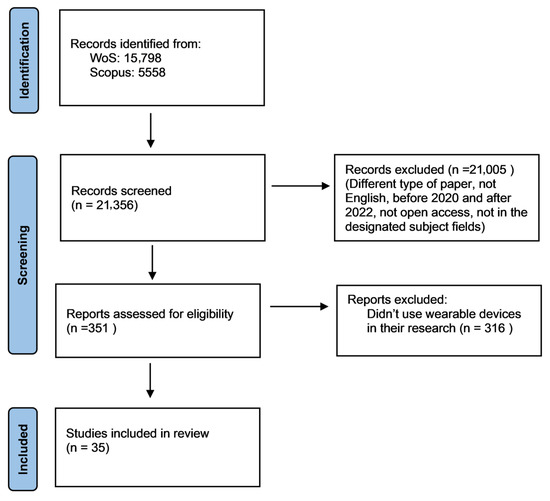
Figure 1.
Identification of studies via databases (adapted from The PRISMA 2020 Statement).
2.3. Inclusion Criteria
In order to narrow down the selection, specific inclusion criteria were applied. The criteria included open access articles written in English, published within the last three years (2020–2022), and falling within subject categories related to Sport Sciences (in WoS CC) and Health Professions and Medicine (in Scopus), which encompass areas such as Sports Therapy and Rehabilitation and Orthopedics and Sports Medicine. Open-access articles are included to ensure accessibility and transparency in the research. Articles in English are selected for consistency and to facilitate a wider readership. Annual scope was chosen to follow the growth of use and influence of social distance measures during the pandemic years (research conducted before and during pandemic). Studies falling within categories related to Sport Sciences (WoS CC) and Health Professions and Medicine (Scopus) are included because they are more likely to contain research on wearable technology within the context of sports, physical activity, and health. Studies were considered if they made clear the sort of monitoring tool used and the physical activity (PA) component being measured, especially if they mentioned it in the methodology. Additionally, studies that focused on activities of daily living (ADL), which involve people engaging in a variety of activities as opposed to being inactive, were included. This information is essential for a comprehensive analysis of the effectiveness and applicability of wearable technology.
2.4. Exclusion Criteria
Conversely, exclusion criteria were also applied. Papers that fell into non-sport-related subject categories or were classified as professional papers or conference proceedings were excluded since our primary goal was to find original scientific papers in sport-related fields. Professional papers or conference proceedings are often preliminary or may not undergo the same level of rigorous peer review as original scientific papers. By excluding them, the study emphasizes a higher standard of research validity and reliability. Furthermore, because we sought to look at publications that verified the use and efficacy of wearables, research that primarily relied on surveys to evaluate the adoption of wearable technology was not taken into consideration in the quality assessment process. Excluding them ensures a stronger focus on studies that directly investigate the utility of wearables in sports and physical activity.
2.5. Execution
The execution phase of the search was a meticulous process involving strategic keyword searches within specific fields of the chosen databases, Scopus and Web of Science Core Collection (WoS CC). The aim was to identify studies that align with our research questions and inclusion criteria. In Scopus database, we employed the option Search within Article title, Abstract, and Keywords, while in WoS CC, we decided to include All fields based on authors experience with previous conducted searches to capture potential matches across various sections. In the beginning the terms used were “smartwatch”, “smart shoes”, “smart clothing”, “smart ring”, “smart belt”, and “smart glasses”. During the initial phase, it was recognized that researchers often use different terminology to refer to wrist-worn wearable devices. This led to a refinement in our research method. We started with the keyword “smartwatch” and introduced Boolean logic with the term “OR” to encompass related keywords, namely “fitness watch” and “sport watch.” This adaptation aimed to capture the diversity of terminologies used to describe wearable devices worn on the wrist. In Scopus database we put the keywords in quotation marks to find exact matches, while they were not necessary in WoS CC. Following the application of our refined selection criteria, we retained 351 papers out of the initial pool of 21,356 studies (as documented in Table 1). To ensure the quality and rigor of the final selection, a thorough quality assessment was undertaken. This involved a comprehensive review of the title, abstract, and methodology of each paper. By subjecting the papers to this critical evaluation, we aimed to identify studies that best align with our research objectives and demonstrate a high level of methodological integrity.

Table 1.
Search process.
2.6. Data Extraction and Organization
To facilitate analysis, relevant data from the selected articles were extracted and organized into nine categories using Excel, Microsoft, Redmond, WA, USA (https://en.wikipedia.org/wiki/Microsoft_Excel). The extracted data included the title of the papers, the number of authors, the year of publication, authors affiliations, the type of wearable monitoring device used, the type of activity being measured, and the area of research (sport training, physical activity, or activities of daily living). Table 2 presents a list of the original scientific papers that were selected for inclusion in this review with information about the type of monitoring device used as well as the area of research.

Table 2.
Selected articles after quality assessment.
In summary, this review aims to provide an extensive analysis of the literature on wearable measuring devices in sport training (ST) and physical activity (PA). By addressing specific research questions and employing systematic literature search methods, the goal is to gain insights into the trends, advancements, and applications of wearables within this domain.
3. Results
The initial focus of our study was to analyze the recent trends in research involving monitoring devices over the past three years. Specifically, we targeted the years 2020, 2021, and 2022 to investigate the potential impact of the COVID-19 pandemic-related quarantine measures and to understand the evolving adoption of wearable devices. There were nine papers published in 2020, nine papers in 2021 and seventeen papers in 2022, showing almost the same number in the first two years and a significant rise in the last year (Figure 2). The consistent number of papers in the initial two years followed by a substantial surge in the final year indicates a significant growth in interest in wearable device research.
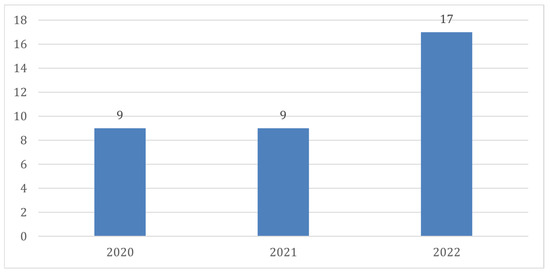
Figure 2.
Number of articles by year.
After quality assessment, we found ten studies conducted prior to the COVID-19 pandemic, with five being undertaken in 2019 and another five in preceding years. Meanwhile, 11 studies were carried out post-March 2020, coinciding with the World Health Organization’s declaration of the pandemic. Intriguingly, 14 studies lacked specific year indications for their research conduct. Among these unspecified studies, 11 were eventually published between 2021 and 2022, while 3 were published in 2020 (Figure 3).
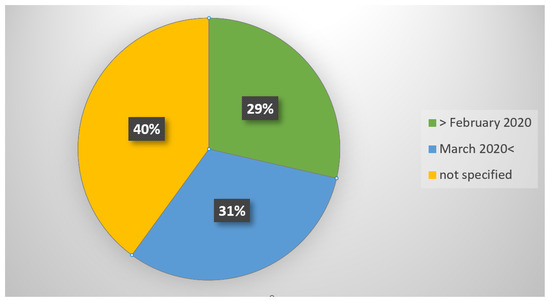
Figure 3.
Number of conducted research before or after pandemic.
To study the relationship of authors and co-authors we explored the composition of authorship in 35 chosen articles (Figure 4). Out of total of 199 authors, Billy Sperlich emerged as one of the most prolific contributors, with an involvement in four distinct papers, followed closely by Peter Düking, who contributed to three. There are 19 authors who wrote two papers: Emelia J. Benjamin, Belinda Borrelli, Kelsey Fusco, Michael M. Hammond, Hans-Christer Holmberg, Vik Kheterpal, Jelena Kornej, Honghuang Lin, Chunyu Liu, Emily S. Manders, David D. McManus, Joanne M. Murabito, Christopher Nowak, Chathurangi H. Pathiravasan, Mayank Sardana, Nicole L. Spartano, Ludovic Trinaquart, Bas Van Hooren, and Yuankai Zhang. This indicates that a group of researchers are consistently engaged in this field. The remaining 178 authors each contributed to a single paper over the last three years, highlighting the diversity of contributors within this domain.
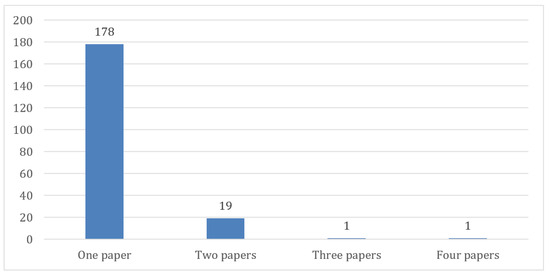
Figure 4.
Number of publications per author.
Another valuable piece of information was the number of authors per paper. None of the selected articles were the sole work of an independent author; rather, a collective approach prevailed. Notably, papers authored by six individuals constituted the largest proportion, accounting for 28% of the sample (ten papers). This was closely followed by papers with four authors (17%, six papers), three authors (11%, four papers), and five authors (11%, four papers). Additionally, papers authored by seven, eight, eleven, and seventeen individuals each represented 6% of the sample, with two papers per category. In contrast, papers authored by two, nine, and ten individuals constituted a smaller percentage of 3% each, with one paper for each category (Figure 5).
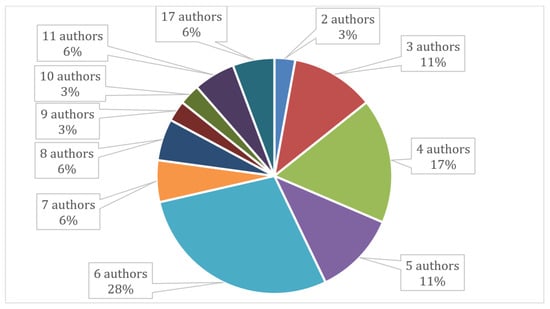
Figure 5.
Number of authors per paper.
We directed our inquiry towards discerning the types of monitoring devices preferred by researchers in their investigations. Categorizing these devices into five distinct groups—shoes and insoles, sport watches, smartphones, fitness trackers, and smart clothing systems—we identified a total of 44 devices employed across various studies (as illustrated in Figure 6). Smartphones used were both Android (1) and iOS (2), while fitness trackers included Fitbit (6), Mymo (1), and Misfit Shine (1). Additionally, research included the use of smart clothing systems, such as COTS smart socks and the hitoe system. Predominantly used smartwatches in articles were ActiGraph, Apple, Coros, Fossil, Garmin, Huawei, Polar, Samsung, Suunto, and Xiaomi.
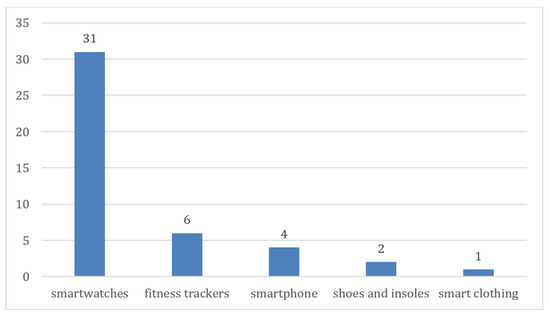
Figure 6.
Most used measuring devices.
The next fundamental question we posed was: which activity was measured with wearables in their research? Our analysis revealed a diverse array of activities, such as walking, running, cycling, climbing, jumping, weightlifting, training exercises (running, tennis, kayaking, and canoeing), and activities of daily living. Additionally, a few studies delved into the monitoring of resting behaviors and other physiological responses. Specifically, one paper monitored sleep routine and stress levels during exercising for e-sports [29] and another documented sleep patterns as a part of training program [46].
Differentiating between research focusing on sports training monitoring and that which emphasized physical activity observation, we uncovered three primary categories: sport training (six studies), physical activity (twenty-six studies), and activities of daily living (nine studies). Some studies bridged these categories by examining both activities of daily living and physical activities (Figure 7). One paper observed sleeping routine and stress levels while training, which was included in sport training [29], while another paper examined activity of workload [44], which was included in activities of daily living. Also, several papers examined ADL in addition with physical activities [28,30,34,39,43]. Within these studies, the objectives varied, with 7 studies concentrating on assessing the reliability and accuracy of devices, while the remaining 29 utilized smart technology as a means of data collection. Various studies have performed interventions in their research using or monitoring with wearable devices [14,16,17,23,26,37,42,45]. Two papers examined the correlation between physical activity or sport and the COVID-19 pandemic using wearables [26,46].
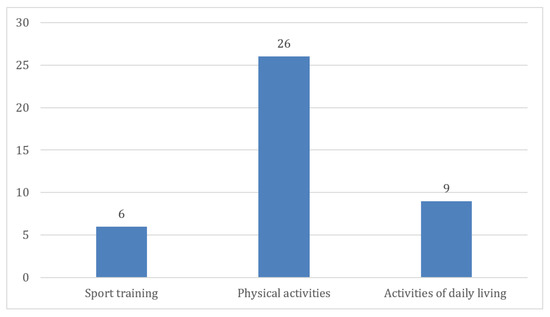
Figure 7.
Categories of activities.
In summary, our investigation encompassed multiple dimensions of wearable device research within the last three years. We examined publication trends, temporal shifts, authorship dynamics, institutional affiliations, device preferences, monitored activities, and the research aims associated with these investigations. This comprehensive analysis offers a rich understanding of the landscape of wearable device research and its evolution over this period.
4. Discussion
The analysis of the study’s results revealed an intriguing pattern in the distribution of research over the specified time periods. The initial two years exhibited a relatively smaller volume of studies, with each year accounting for nine studies. However, the year 2022 saw a notable surge in the number of studies, totaling 17. The primary objective of this research was to contrast the number of studies conducted during the pre-pandemic year (2019) with those carried out in the early pandemic years (2020–2022). This analysis aimed to discern the potential influence of social distancing measures on the utilization of wearable devices in various studies.
Interestingly, the findings uncovered a distinct issue within the dataset. A significant proportion, 40% (14 studies), did not specify the year in which the research was conducted, rendering them inconclusive in the context of this analysis. Among the discernible studies, 29% (10 studies) were conducted prior to the pandemic, while 31% (11 studies) were conducted in the post-pandemic period. Notably, of the 14 unspecified studies, 11 were published in 2021 and 2022. Assuming a time gap between research and publication, it can be inferred that these studies were conducted after the declaration of the pandemic. This suggests that the trend of wearable device usage was on the rise even before the pandemic, and this growth continued during the era of social distancing and other preventive measures.
Furthermore, the analysis underscores the scarcity of research explicitly investigating the use of wearables in the context of COVID-19 conditions. Only two papers explored the application of wearables during these conditions, indicating that a substantial number of studies concerning COVID-19 are likely to emerge in the coming years. Consequently, a comprehensive literature review on this specific subject will be feasible once a substantial body of relevant research is available. This pattern also highlights a prevalent issue where a significant number of studies omit the precise date of their research, impeding literature reviews that necessitate a temporal context.
The study also provides insights into the publication trends of authors in the field. Additionally, the majority of authors only published one paper in which they made use of monitoring devices, aligning with the expectation that these devices were predominantly used as a tool rather than central focus of investigation. Authors Peter Düking (three papers) and Billy Sperlich (four papers) stand out with the highest number of contributions. They collaborated on three of these papers, concentrating on the validation of various wearables and exploring physical activity using specific wearable devices which indicates their keen interest in exploring diverse facets of wearable technology usage and effectiveness within the domain of sport sciences.
Additionally, the distribution of authorship highlights an interesting trend. Among the 19 authors who authored two papers, 17 of them participated in the same research projects [25,31]. None of the included papers were the work of independent researchers. This pattern reflects the evolving nature of authorship across contemporary scientific disciplines, where collaborative efforts involving a multitude of co-authors are increasingly prevalent [47]. It is to be seen if this kind of research is in its beginnings or if researchers prefer other types of measuring devices.
The analysis of wearable device preferences aligns with the hypothesis that smartwatches would dominate as the most utilized monitoring wearables. Device preferences reflect the versatility of wearable technologies. Researchers and participants chose a wide variety of watches but the most popular were commercially available ones (Polar, Apple and Garmin) with several studies that selected more than just one. Similarly, Fitbit emerged as the primary choice for fitness trackers. Considering those are easily available and popular in recreational use, the results are more than expected. The diverse range of devices, including those tailored for specific applications like smart clothing systems, attests to the growing innovation in wearable technology. Such diversity accommodates the distinct monitoring needs of various activities and populations, making wearable devices adaptable tools for research across domains. The small number of other devices is enlightening for future studies.
While observing different activities, it was surprising to find a diverse and large number of recreational activities as well as daily living activities. In contrast, the number of training exercises and their distinction was smaller than expected, only five studies altogether, which refuted the hypothesis that measurable devices are used more in sport training (Figure 6). Scientists were more focused on evaluating, monitoring, and promoting physical activity to non-active users and understanding the validity of devices. As expected, studies involving recreational activities predominantly targeted specific groups, while there were also investigations into adapted physical activities geared toward the health needs of the elderly or ill populations. Smartwatches have oftentimes been used in healthcare, so these results are not surprising. Activities of daily living were mostly inspected with youth groups, the elderly, and people with diseases aiming to assess their functional capacities. The lowest number of studies in sport training showed an obvious shortage of research that uses wearables with monitoring training process. The reason for that could be the question of accuracy that arises with self-monitoring [48] or different technological challenges [3]. Additionally, top athletes often rely on coach assessments, a facet that warrants thorough exploration in future research. The limited number of intervention studies demonstrating positive outcomes from physical activity interventions underscores the potential for further investigations in this domain.
Limitations
The limitations of the current study should be taken into consideration while evaluating its results. Limitations include the following:
Search Strategy: The choice of specific keywords for the literature search may have omitted relevant studies that used different terminology. This could potentially lead to the exclusion of valuable research on wearable devices.
Publication Bias: The study focused on open access articles published in English, which might introduce publication bias by excluding non-English articles.
Time Span: We narrowed the time filter to see the effect of pandemic on our subject but the results showed large number of unspecified studies which resulted in unconclusive results. A longer timeframe might provide a more comprehensive understanding of trends, especially in relation to the ongoing development and adoption of wearable technology.
5. Conclusions
In conclusion, this comprehensive review of the literature has shed light on the widespread use and increasing popularity of wearable measuring devices in the domains of sports and physical activity. This research found 35 studies in the last three years that observed the use of monitoring devices in sport and physical activity. Furthermore, we discovered a large use of wearables before the pandemic and that there is also continuing growth in its use after the pandemic and social distancing measures. The analysis has revealed the dominance of smartwatches and fitness trackers among the chosen devices, with a notable emphasis on monitoring physical activity and promoting health behaviors. However, a noticeable research gap exists when it comes to studying the application of wearable devices in sport training monitoring. Contrary to the unbiased data the wearables have been demonstrated to provide, this result suggests that researchers may still be unsure of their effectiveness or lack a basic understanding of the algorithms.
Authorship dynamics revealed a mix of prolific authors, consistent contributors, and those who engaged in singular studies. The dominance of collaborative authorship aligns with the multidisciplinary nature of wearable device research, necessitating expertise in various domains, including technology, sports science, and health. The presence of a few researchers contributing to multiple papers indicates specialization and commitment to advancing this field. On the other hand, a diverse range of authors who contributed to single papers underscores the inclusivity and accessibility of wearable device research.
Additionally, the field could benefit from more intervention studies that explore the effectiveness of wearables in promoting physical activity and enhancing health outcomes across diverse user groups. By addressing these gaps, researchers can contribute to a more comprehensive understanding of wearable technology’s role in shaping the landscape of sports, physical activity, and overall well-being.
The findings presented here provide a foundation for future research directions, highlighting areas where further investigation is warranted to uncover the full potential of wearable technology in various domains.
Author Contributions
Conceptualization, D.P.; methodology I.B.; software, I.Č.; validation, M.B. and J.R.; formal analysis I.B.; investigation, I.B. and I.Č.; resources, I.B.; data curation, I.Č.; writing—original draft preparation, I.B.; writing—review and editing, D.P.; visualization, J.R.; supervision, M.B.; project administration, D.P.; funding acquisition, M.B. All authors have read and agreed to the published version of the manuscript.
Funding
This research received no external funding.
Institutional Review Board Statement
Not applicable.
Informed Consent Statement
Not applicable.
Data Availability Statement
Not applicable.
Conflicts of Interest
The authors declare no conflict of interest.
References
- Pingo, Z.; Narayan, B. “My smartwatch told me to see a sleep doctor”: A study of activity tracker use. Online Inf. Rev. 2020, 44, 503–519. [Google Scholar] [CrossRef]
- Thompson, W.R.; FACSM. Worldwide Survey of Fitness Trends for 2023. ACSM’s Health Fit. J. 2023, 27, 9–18. [Google Scholar] [CrossRef]
- King, C.E.; Sarrafzadeh, M. A Survey of Smartwatches in Remote Health Monitoring. J. Healthc. Inform. Res. 2018, 2, 1–24. [Google Scholar] [CrossRef] [PubMed]
- Horbylon Nascimento, T.; Ferreira, C.B.R.; Rodrigues, W.G.; Soares, F. Interaction with Smartwatches Using Gesture Recognition: A Systematic Literature Review. In Proceedings of the 2020 IEEE 44th Annual Computers, Software, and Applications Conference (COMPSAC), Virtual, 13–17 July 2000. [Google Scholar] [CrossRef]
- Nazarian, S.; Lam, K.; Darzi, A.; Ashrafian, H. Diagnostic accuracy of smartwatches for the detection of cardiac arrhythmia: Systematic review and meta-analysis. J. Med. Internet Res. 2021, 23, e28974. [Google Scholar] [CrossRef]
- Chandel, R.S.; Sharma, S.; Kaur, S.; Singh, S.; Kumar, R. Smart watches: A review of evolution in bio-medical sector. Mater. Today Proc. 2021, 50, 1053–1066. [Google Scholar] [CrossRef]
- Panicker, R.M.; Chandrasekaran, B. “Wearables on vogue”: A scoping review on wearables on physical activity and sedentary behavior during COVID-19 pandemic. Sport Sci. Health 2022, 18, 641–657. [Google Scholar] [CrossRef]
- Channa, A.; Popescu, N.; Skibinska, J.; Burget, R. The rise of wearable devices during the COVID-19 pandemic: A systematic review. Sensors 2021, 21, 5787. [Google Scholar] [CrossRef]
- Jat, A.S.; Grønli, T.-M. Smart Watch for Smart Health Monitoring: A Literature Review. In Proceedings of the Bioinformatics and Biomedical Engineering, 9th International Work-Conference, Maspalomas, Gran Canaria, Spain, 27–30 June 2022. [Google Scholar] [CrossRef]
- Motahari-Nezhad, H.; Zare, F.; Akbari, H.; Sadeghdaghighi, A. Health outcomes of Fitbit, Garmin or Apple Watch-based interventions: A systematic review of systematic reviews. Balt. J. Health Phys. Act. 2022, 14, 8. [Google Scholar]
- Pay, L.; Yumurtaş, A.Ç.; Satti, D.I.; Hui, J.M.H.; Chan, J.S.K.; Mahalwar, G.; Lee, Y.H.A.; Tezen, O.; Birdal, O.; Inan, D.; et al. Arrhythmias Beyond Atrial Fibrillation Detection Using Smartwatches: A Systematic Review. Anatol. J. Cardiol. 2023, 27, 126–131. [Google Scholar] [CrossRef]
- Boateng, G.; Petersen, C.L.; Kotz, D.; Fortuna, K.L.; Masutani, R.; Batsis, J.A. A Smartwatch Step-Counting App for Older Adults: Development and Evaluation Study. JMIR Aging 2022, 5, e33845. [Google Scholar] [CrossRef]
- Boillat, T.; Kourie, A.; Thalange, N.; Du Plessis, S.; Loney, T. Guinness World Record: Personal Experience and Physiological Responses of a Non-Professional Athlete Successfully Covering 620 Km in 7-Days by Foot Across the United Arab Emirates. J. Sports Sci. Med. 2022, 21, 267–276. [Google Scholar] [CrossRef] [PubMed]
- Brake, M.; Stolwijk, N.; Staal, B.; Van Hooren, B. Using Beat Frequency in Music to Adjust Running Cadence in Recreational Runners: A Randomized Multiple Baseline Design. Eur. J. Sport Sci. 2022, 23, 345–354. [Google Scholar] [CrossRef] [PubMed]
- Climstein, M.; Alder, J.L.; Brooker, A.M.; Cartwright, E.J.; Kemp-Smith, K.; Simas, V.; Furness, J. Reliability of the Polar Vantage M Sports Watch When Measuring Heart Rate at Different Treadmill Exercise Intensities. Sports 2020, 8, 117. [Google Scholar] [CrossRef] [PubMed]
- Düking, P.; Giessing, L.; Frenkel, M.O.; Koehler, K.; Holmberg, H.C.; Sperlich, B. Wrist-worn wearables for monitoring heart rate and energy expenditure while sitting or performing light-to-vigorous physical activity: Validation study. JMIR Mhealth Uhealth 2020, 8, e16716. [Google Scholar] [CrossRef] [PubMed]
- Düking, P.; Tafler, M.; Wallmann-Sperlich, B.; Sperlich, B.; Kleih, S. Behavior change techniques in wrist-worn wearables to promote physical activity: Content analysis. JMIR Mhealth Uhealth 2020, 8, e20820. [Google Scholar] [CrossRef]
- Düking, P.; Van Hooren, B.; Sperlich, B. Assessment of Peak Oxygen Uptake with a Smartwatch and its Usefulness for Training of Runners. Int. J. Sports Med. 2022, 43, 642–647. [Google Scholar] [CrossRef]
- Fleming, J.A.; Corr, L.D.; Earle, J.; Naughton, R.J.; Harper, L.D. Significant Energy Deficit and Suboptimal Sleep During a Junior Academy Tennis Training Camp. Pediatr. Exerc. Sci. 2022, 34, 162–167. [Google Scholar] [CrossRef]
- Fuller, D.; Anaraki, J.R.; Simango, B.; Rayner, M.; Dorani, F.; Bozorgi, A.; Luan, H.; Basset, F.A. Predicting Lying, Sitting, Walking and Running Using Apple Watch and Fitbit Data. BMJ Open Sport Exerc. Med. 2021, 7, e001004. [Google Scholar] [CrossRef]
- Garnacho-Castaño, M.V.; Faundez-Zanuy, M.; Serra-Payá, N.; Maté-Muñoz, J.L.; López-Xarbau, J.; Vila-Blanch, M. Reliability and Validity of the Polar V800 Sports Watch for Estimating Vertical Jump Height. J. Sports Sci. Med. 2021, 20, 149–157. [Google Scholar] [CrossRef]
- Gilgen-Ammann, R.; Schweizer, T.; Wyss, T. Accuracy of Distance Recordings in Eight Positioning-Enabled Sport Watches: Instrument Validation Study. JMIR Mhealth Uhealth 2020, 8, e1711. [Google Scholar] [CrossRef]
- Golbus, J.R.; Gupta, K.; Stevens, R.; Jeganathan, V.S.; Luff, E.; Boyden, T.; Mukherjee, B.; Klasnja, P.; Kheterpal, S.; Kohnstamm, S.; et al. Understanding Baseline Physical Activity in Cardiac Rehabilitation Enrollees Using Mobile Health Technologies. Circ. Cardiovasc. Qual. Outcomes 2022, 15, e009182. [Google Scholar] [CrossRef] [PubMed]
- Gruber, M.; Peltonen, J.; Bartsch, J.; Barzyk, P. The Validity and Reliability of Counter Movement Jump Height Measured with the Polar Vantage V2 Sports Watch. Front. Sports Act. Living 2022, 4, 1013360. [Google Scholar] [CrossRef] [PubMed]
- Hammond, M.M.; Zhang, Y.; Pathiravasan, C.H.; Lin, H.; Sardana, M.; Trinquart, L.; Benjamin, E.J.; Borrelli, B.; Manders, E.S.; Fusco, K.; et al. Relations between BMI Trajectories and Habitual Physical Activity Measured by a Smartwatch in the Electronic Cohort of the Framingham Heart Study: Cohort Study. JMIR Cardio 2022, 6, e32348. [Google Scholar] [CrossRef] [PubMed]
- Hojjatinia, S.; Lee, A.M.; Hojjatinia, S.; Lagoa, C.M.; Brunke-Reese, D.; Conroy, D.E. Physical Activity Dynamics during a Digital Messaging Intervention Changed after the Pandemic Declaration. Ann. Behav. Med. 2022, 56, 1188–1198. [Google Scholar] [CrossRef] [PubMed]
- Joo, H.; Kim, H.; Ryu, J.K.; Ryu, S.; Lee, K.M.; Kim, S.C. Estimation of Fine-Grained Foot Strike Patterns With Wearable Smartwatch De Ices. Int. J. Environ. Res. Public Health 2022, 19, 1279. [Google Scholar] [CrossRef] [PubMed]
- Khanshan, A.; Van Gorp, P.; Nuijten, R.; Markopoulos, P. Assessing the influence of physical activity upon the experience sampling response rate on wrist-worn devices. Int. J. Environ. Res. Public Health 2021, 18, 10593. [Google Scholar] [CrossRef]
- Klier, K.; Seiler, K.; Wagner, M. Influence of esports on Sleep and Stress. Z. Fur. Sportpsychol. 2022, 29, 95–103. [Google Scholar] [CrossRef]
- LaMunion, S.R.; Blythe, A.L.; Hibbing, P.R.; Kaplan, A.S.; Clendenin, B.J.; Crouter, S.E. Use of consumer monitors for estimating energy expenditure in youth. Appl. Physiol. Nutr. Metab. 2020, 45, 161–168. [Google Scholar] [CrossRef]
- Lin, H.; Sardana, M.; Zhang, Y.; Liu, C.; Trinquart, L.; Benjamin, E.J.; Manders, E.S.; Fusco, K.; Kornej, J.; Hammond, M.M.; et al. Association of Habitual Physical Activity with Cardiovascular Disease Risk. Circ. Res. 2020, 127, 1253–1260. [Google Scholar] [CrossRef]
- Lövdal, S.S.; Den Hartigh, R.J.R.; Azzopardi, G. Injury Prediction in Competitive Runners with Machine Learning. Int. J. Sports Physiol. Perform. 2021, 16, 1522–1531. [Google Scholar] [CrossRef]
- Martinato, M.; Lorenzoni, G.; Zanchi, T.; Bergamin, A.; Buratin, A.; Azzolina, D.; Gregori, D. Usability and Accuracy of a Smartwatch for the Assessment of Physical Activity in the Elderly Population: Observational Study. JMIR Mhealth Uhealth 2021, 9, e20966. [Google Scholar] [CrossRef]
- Mukaino, M.; Ogasawara, T.; Matsuura, H.; Aoshima, Y.; Suzuki, T.; Furuzawa, S.; Yamaguchi, M.; Nakashima, H.; Saitoh, E.; Tsukada, S.; et al. Validity of trunk acceleration measurement with a chest-worn monitor for assessment of physical activity intensity. BMC Sports Sci. Med. Rehabil. 2022, 14, 104. [Google Scholar] [CrossRef] [PubMed]
- Oberhofer, K.; Erni, R.; Sayers, M.; Huber, D.; Lüthy, F.; Lorenzetti, S. Validation of a Smartwatch-Based Workout Analysis Application in Exercise Recognition, Repetition Count and Prediction of 1rm in the Strength Training-Specific Setting. Sports 2021, 9, 118. [Google Scholar] [CrossRef] [PubMed]
- Papavasileiou, I.; Qiao, Z.; Zhang, C.; Zhang, W.; Bi, J.; Han, S. GaitCode: Gait-Based Continuous Authentication Using Multimodal Learning and Wearable Sensors. Smart Health 2021, 19, 100162. [Google Scholar] [CrossRef]
- Piau, A.; Steinmeyer, Z.; Charlon, Y.; Courbet, L.; Rialle, V.; Lepage, B.; Campo, E.; Nourhashemi, F. A Smart Shoe Insole to Monitor Frail Older Adults’ Walking Speed: Results of Two Evaluation Phases Completed in a Living Lab and through a 12-Week Pilot Study. JMIR MHealth UHealth 2021, 9, e15641. [Google Scholar] [CrossRef] [PubMed]
- Ruiz-Alias, S.A.; Marcos-Blanco, A.; Clavero-Jimeno, A.; García-Pinillos, F. Examining Weekly Heart Rate Variability Changes: A Comparison between Wearable Devices Running Head: Weekly Heart Rate Variability Changes. Sports Eng. 2022, 25, 7. [Google Scholar] [CrossRef]
- Savi, D.; Graziano, L.; Giordani, B.; Schiavetto, S.; De Vito, C.; Migliara, G.; Simmonds, N.J.; Palange, P.; Elborn, J.S. New Strategies of Physical Activity Assessment in Cystic Fibrosis: A Pilot Study. BMC Pulm. Med. 2020, 20, 285. [Google Scholar] [CrossRef]
- Schmidle, S.; Gulde, P.; Herdegen, S.; Böhme, G.E.; Hermsdörfer, J. Kinematic Analysis of Activities of Daily Living Performance in Frail Elderly. BMC Geriatr. 2022, 22, 244. [Google Scholar] [CrossRef]
- Takayama, F.; Mori, H. The Relationship between 24 h Ultramarathon Performance and the “Big Three” Strategies of Training, Nutrition, and Pacing. Sports 2022, 10, 162. [Google Scholar] [CrossRef]
- Troschel, F.M.; Ramroth, C.; Lemcke, L.; Clasing, J.; Troschel, A.S.; Dugas, M.; Stummer, W.; Wiewrodt, R.; Brandt, R.; Wiewrodt, D. Feasibility, safety and effects of a one-week, ski-based exercise intervention in brain tumor patients and their relatives: A pilot study. J. Clin. Med. 2020, 9, 1006. [Google Scholar] [CrossRef]
- Viciana, J.; Casado-Robles, C.; Guijarro-Romero, S.; Mayorga-Vega, D. Are Wrist-Worn Activity Trackers and Mobile Applications Valid for Assessing Physical Activity in High School Students? Wearfit Study. J. Sports Sci. Med. 2022, 21, 356–375. [Google Scholar] [CrossRef] [PubMed]
- Wang, X.; Perry, T.A.; Caroupapoullé, J.; Forrester, A.; Arden, N.K.; Hunter, D.J. Monitoring work-related physical activity and estimating lower-limb loading: A proof-of-concept study. BMC Musculoskelet. Disord. 2021, 22, 552. [Google Scholar] [CrossRef]
- Yang, G.; Shangguan, R.; Ke, Y.; Wang, S. The Influence of Acute Aerobic Exercise on Craving Degree for University Students with Mobile Phone Dependency: A Randomized Controlled Trial. Int. J. Environ. Res. Public Health 2022, 19, 8983. [Google Scholar] [CrossRef] [PubMed]
- Zinner, C.; Matzka, M.; Leppich, R.; Kounev, S.; Holmberg, H.-C.; Sperlich, B. The Impact of the German Strategy for Containment of Coronavirus SARS-CoV-2 on Training Characteristics, Physical Activity and Sleep of Highly Trained Kayakers and Canoeists: A Retrospective Observational Study. Front. Sports Act. Living 2020, 2, 579830. [Google Scholar] [CrossRef] [PubMed]
- Jokić, M. Bibliometrijski Aspekti Vrednovanja Znanstvenog Rada; [Bibliometric aspects of evaluation of scientific work]; Sveučilišna knjižara: Zagreb, Croatia, 2005; p. 19. [Google Scholar]
- Reeder, B.; David, A. Health at hand: A systematic review of smart watch uses for health and wellness. J. Biomed. Inform. 2016, 63, 269–276. [Google Scholar] [CrossRef] [PubMed]
Disclaimer/Publisher’s Note: The statements, opinions and data contained in all publications are solely those of the individual author(s) and contributor(s) and not of MDPI and/or the editor(s). MDPI and/or the editor(s) disclaim responsibility for any injury to people or property resulting from any ideas, methods, instructions or products referred to in the content. |
© 2023 by the authors. Licensee MDPI, Basel, Switzerland. This article is an open access article distributed under the terms and conditions of the Creative Commons Attribution (CC BY) license (https://creativecommons.org/licenses/by/4.0/).